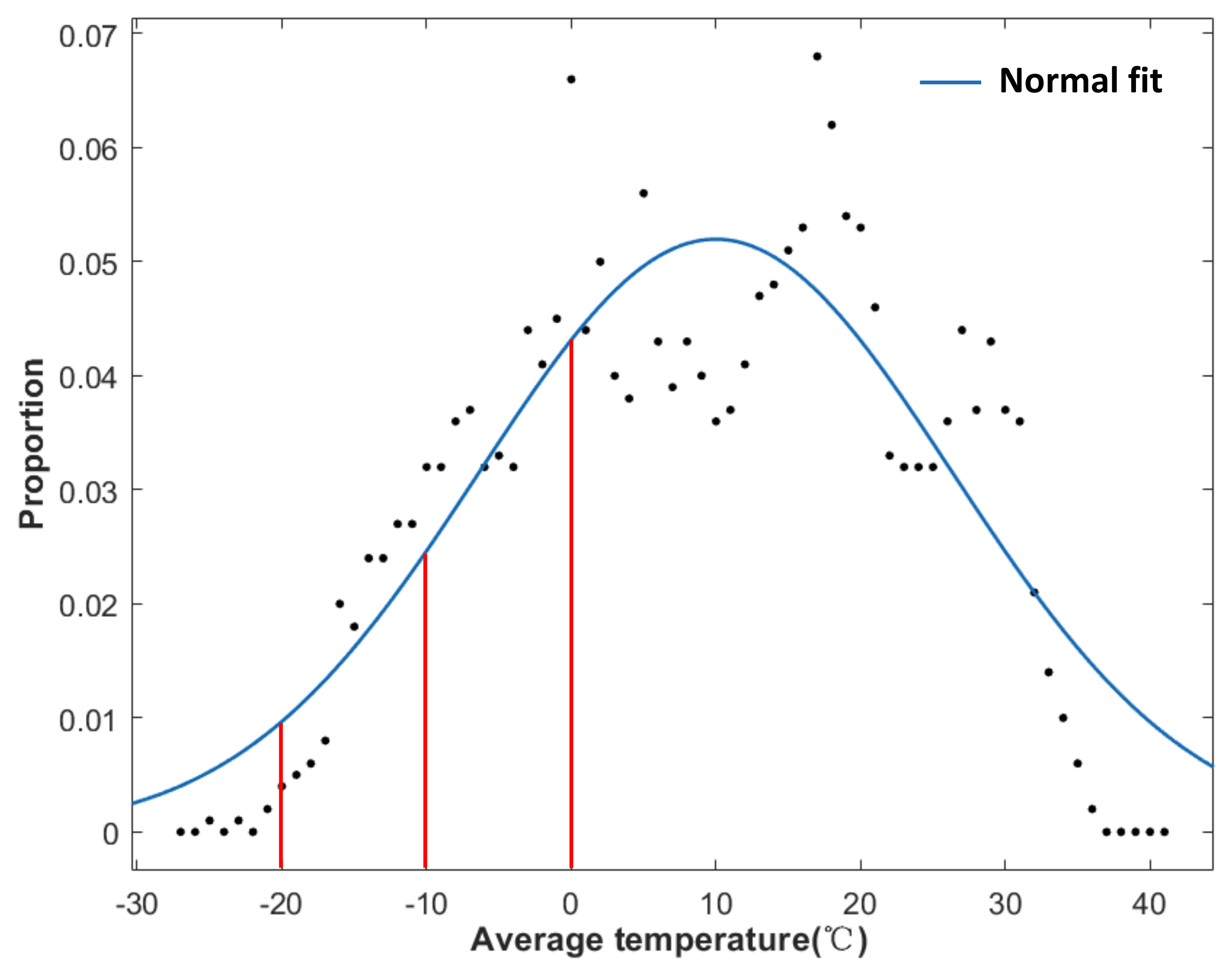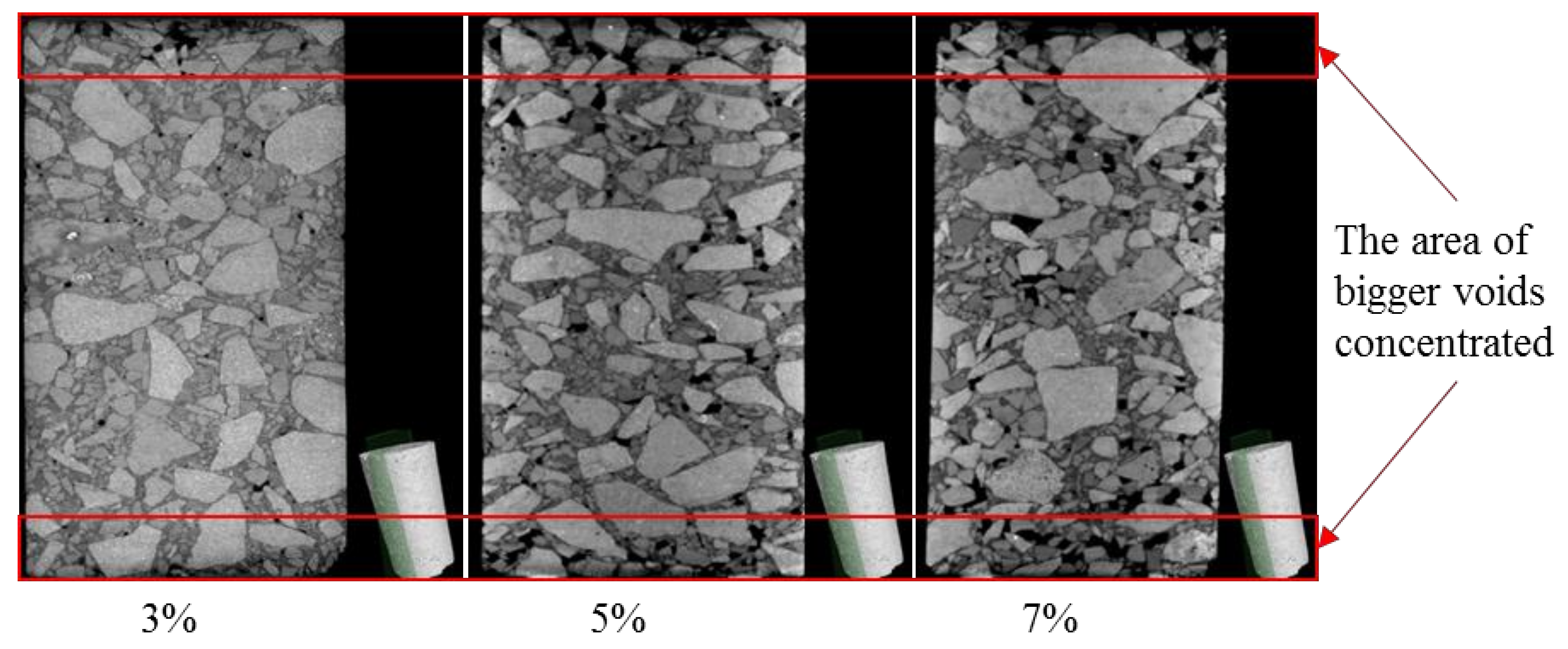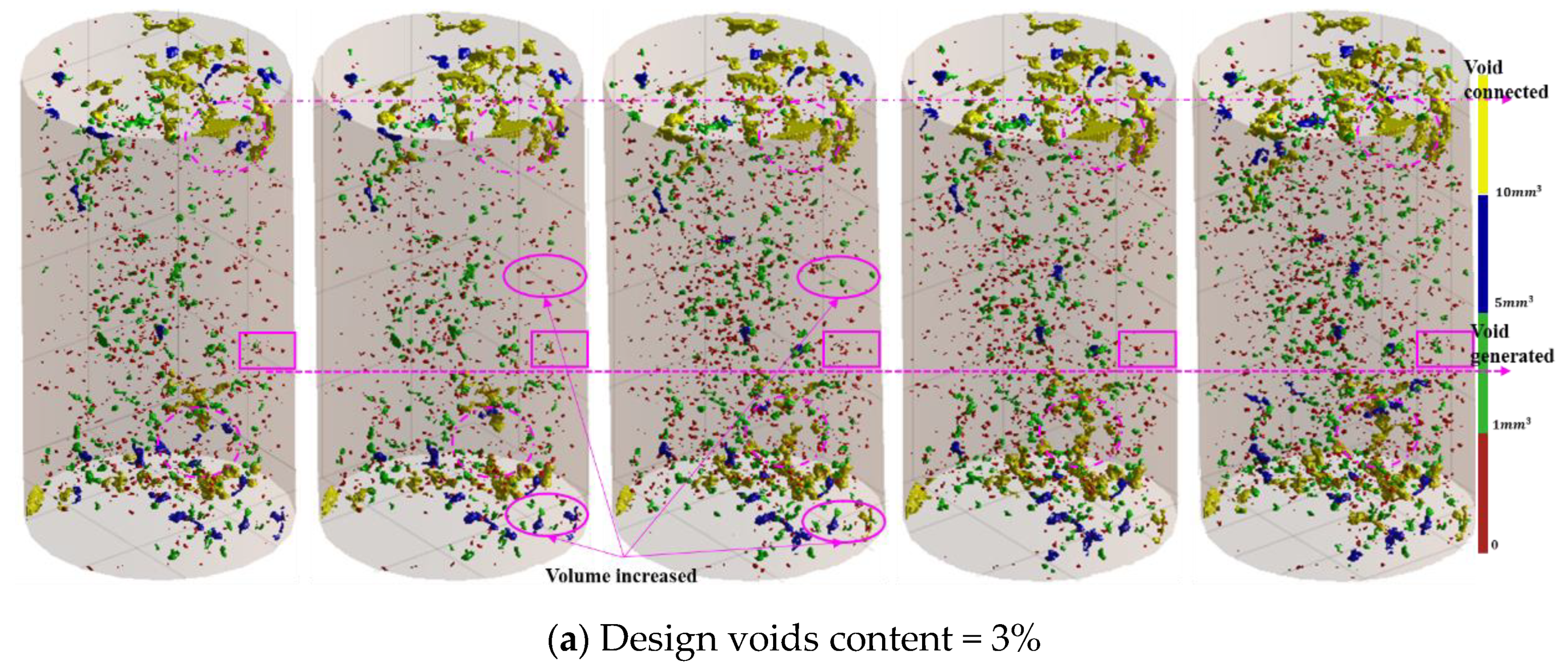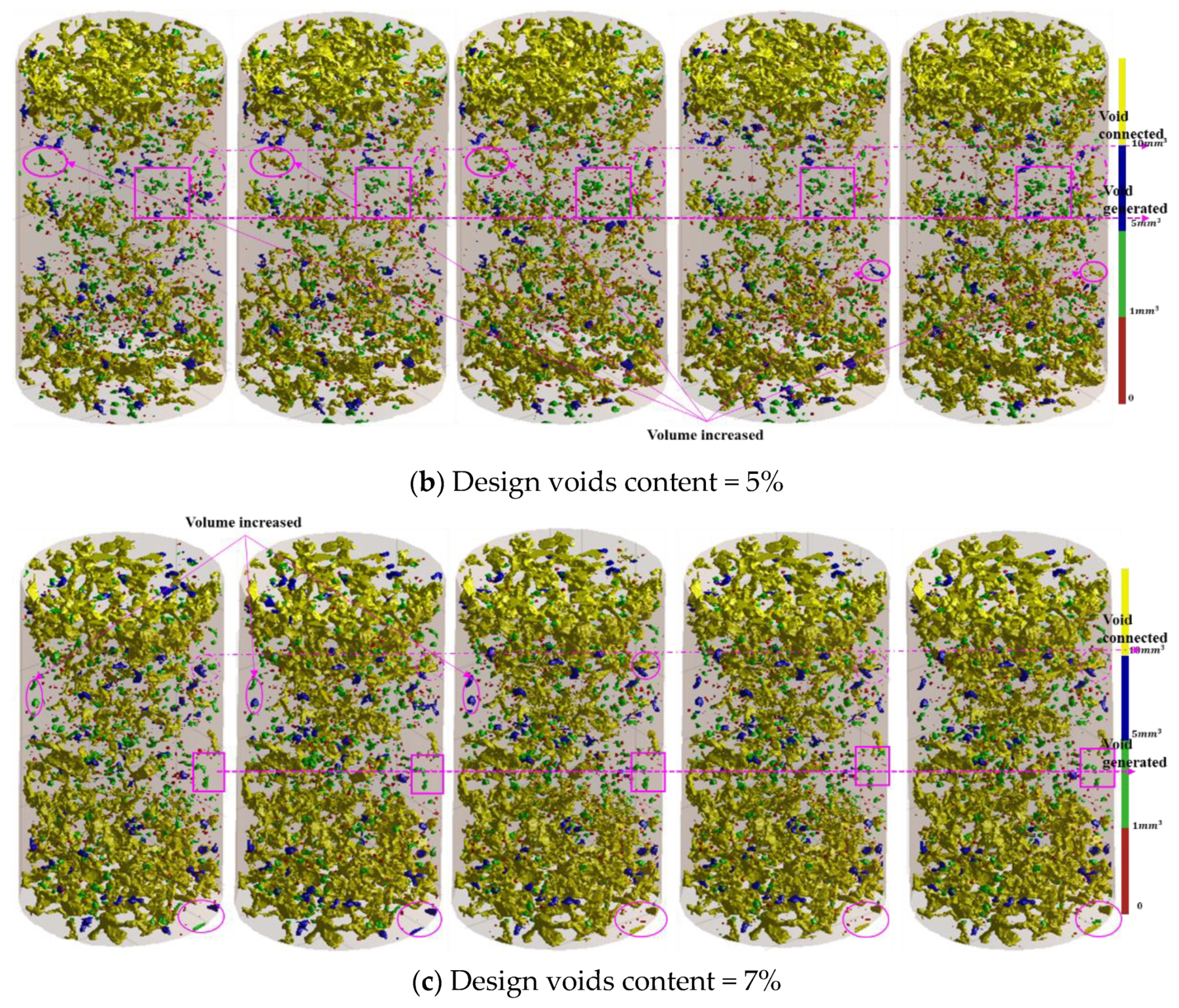Characterization of Three-Dimensional Internal Structure Evolution in Asphalt Mixtures during Freeze–Thaw Cycles
Abstract
:1. Introduction
2. Material and Methods
2.1. Specimen Preparation and Testing
2.2. X-ray Scanning and Digital Image Processing
3. Results and Discussion
3.1. Three-Dimensional Distribution of Air Voids in Asphalt Mixture during Freeze–Thaw Testing
3.2. Changes of 3D Void Parameters of Asphalt Mixture during Freeze–Thaw Cycles
4. Conclusions
Author Contributions
Funding
Institutional Review Board Statement
Informed Consent Statement
Acknowledgments
Conflicts of Interest
References
- Xue-Ning, M.A.; Liang, B.; Gao, F. Study on the Dynamic Properties of Slab Ballastless Track and Subgrade Structure on High-speed Railway. J. China Railw. Soc. 2011, 33, 72–78. [Google Scholar]
- Yang, J. Research on Design of Waterproof and Drainage for Subgrade of Passenger Dedicated Railway. J. Railw. Eng. Soc. 2011, 28, 52–55. [Google Scholar]
- Zhang, L.T.; Ke, W.U.; Zhang, L.W. Study on Waterproofing and Drainage System for Subgrade of Ballastless Track. Soil Eng. Found. 2010, 31, 19–24. [Google Scholar]
- Zhao, G.; Liu, X.; Gao, L.; Cai, X. Characteristic Analysis of Track Irregularity in Subgrade Frost Heave Area of Harbin-Dalian High-speed Railway. J. China Railw. Soc. 2016, 38, 105–109. [Google Scholar]
- Liu, S.; Yang, J.; Chen, X.; Yang, G.; Cai, D. Application of Mastic Asphalt Waterproofing Layer in High-Speed Railway Track in Cold Regions. Appl. Sci. 2018, 8, 667. [Google Scholar] [CrossRef] [Green Version]
- Liu, S.; Yang, J.; Chen, X.; Wang, M.; Zhou, W. Design of Asphalt Waterproofing Layer for High-Speed Railway Subgrade: A Case Study in Heilongjiang Province, China. In Transportation Research Board 96th Annual Meeting; Transportation Research Board: Washington, DC, USA, 2017. [Google Scholar]
- Liu, S.; Markine, V.L.; Chen, X.; Yang, J. Numerical Study on Application of Full Cross-Section Asphalt Waterproof Layer in CRTS III Slab Track. In Transportation Research Board 97th Annual Meeting; Transportation Research Board: Washington, DC, USA, 2018. [Google Scholar]
- Xiahua Chen, T.T.; Yang, G.; Yan, H.; Yang, J. Long-Lasting Waterproofing Solution for the Subgrade of High-Speed Railway in Cold Region. J. Test. Eval. 2018, 47, 1982–1994. [Google Scholar]
- Xu, H.N.; Guo, W.; Tan, Y.Q. Internal structure evolution of asphalt mixtures during freeze-thaw cycles. Mater. Des. 2015, 86, 436–446. [Google Scholar] [CrossRef]
- Mohammad, L.N.; Herath, A.; Huang, B.S.; Trb, T. Evaluation of permeability of Superpave((R)) asphalt mixtures. In Bituminous Paving Mixtures 2003: Materials and Construction; Transportation Research Board Natl Research Council: Washington, DC, USA, 2003; pp. 50–58. [Google Scholar]
- Hainin, M.R.; Yusoff, N.I.M.; Satar, M.; Brown, E.R. The effect of lift thickness on permeability and the time available for compaction of hot mix asphalt pavement under tropical climate condition. Constr. Build. Mater. 2013, 48, 315–324. [Google Scholar] [CrossRef]
- Nagy, S.; Nosko, M.; Orovcik, L.; Izdinsky, K.; Kudela, S.; Krizik, P. Pre-review study of the aluminum/alumina master alloy made through pressure infiltration. Mater. Des. 2015, 66, 1–6. [Google Scholar] [CrossRef]
- Ibrahim, A.; Zhang, F.M.; Otterstein, E.; Burkel, E. Processing of porous Ti and Ti5Mn foams by spark plasma sintering. Mater. Des. 2011, 32, 146–153. [Google Scholar] [CrossRef]
- Masad, E.; Muhunthan, B.; Shashidhar, N.; Harman, T. Internal structure characterization of asphalt concrete using image analysis. J. Comput. Civ. Eng. 1999, 13, 88–95. [Google Scholar] [CrossRef]
- Kutay, M.E.; Ozturk, H.I.; Abbas, A.R.; Hu, C.C. Comparison of 2D and 3D image-based aggregate morphological indices. Int. J. Pavement Eng. 2011, 12, 421–431. [Google Scholar] [CrossRef]
- Coenen, A.R.; Kutay, M.E.; Sefidmazgi, N.R.; Bahia, H.U. Aggregate structure characterisation of asphalt mixtures using two-dimensional image analysis. Road Mater. Pavement Des. 2012, 13, 433–454. [Google Scholar] [CrossRef]
- Krol, J.B.; Khan, R.; Collop, A.C. The study of the effect of internal structure on permeability of porous asphalt. Road Mater. Pavement Des. 2018, 19, 935–951. [Google Scholar] [CrossRef]
- Al-Omari, A.; Tashman, L.; Masad, E.; Cooley, A.; Harman, T. Proposed methodology for predicting HMA permeability (with discussion). J. Assoc. Asph. Paving Technol. 2002, 71, 30–58. [Google Scholar]
- Wang, L.B.; Wang, X.; Mohammad, L.; Wang, Y.P. Application of mixture theory in the evaluation of mechanical properties of asphalt concrete. J. Mater. Civ. Eng. 2004, 16, 167–174. [Google Scholar] [CrossRef]
- Khan, R.; Collop, A.C.; Airey, G.D.; Khan, A.N. Asphalt damage characterisation from cyclic test and X-ray computed tomography. Proc. Inst. Civ. Eng. Transp. 2013, 166, 203–213. [Google Scholar] [CrossRef]
- Khan, R.; Grenfell, J.; Collop, A.; Airey, G.; Gregory, H. Moisture damage in asphalt mixtures using the modified SATS test and image analysis. Constr. Build. Mater. 2013, 43, 165–173. [Google Scholar] [CrossRef]
- Navaro, J.; Bruneau, D.; Drouadaine, I.; Colin, J.; Dony, A.; Cournet, J. Observation and evaluation of the degree of blending of reclaimed asphalt concretes using microscopy image analysis. Constr. Build. Mater. 2012, 37, 135–143. [Google Scholar] [CrossRef]
- Wu, W.L.; Wang, D.Y.; Zhang, X.N. Estimating the Gradation of Asphalt Mixtures using X-Ray Computerized Tomography and Stereology Method. Road Mater. Pavement Des. 2011, 12, 699–710. [Google Scholar] [CrossRef]
- Xu, G.; Yu, Y.; Cai, D.; Xie, G.; Chen, X.; Yang, J. Multi-scale damage characterization of asphalt mixture subject to freeze-thaw cycles. Constr. Build. Mater. 2020, 240, 117947. [Google Scholar] [CrossRef]
- Yan, Q.; Huang, P. Fractal Characteristic of Asphalt Mixture Void. J. Tongji Univ. 2004, 32, 43–48. [Google Scholar]
- Thyagarajan, S.; Tashman, L.; Masad, E.; Bayomy, F. The heterogeneity and mechanical response of hot mix asphalt laboratory specimens. Int. J. Pavement Eng. 2010, 11, 107–121. [Google Scholar] [CrossRef]
- Tan, Y.; Ren, J.; Ji, L.; Xu, Z. Analysis of influencing factors of the test precision of asphalt mixture voids based on X-ray CT. J. Harbin Inst. Technol. 2014, 46, 65–71. [Google Scholar]
- Li, Z.; Tan, Y.; Wu, S.; Yang, F. The effects of the freeze-thaw cycle on the mechanical properties of the asphalt mixture. J. Harbin Eng. Univ. 2014, 35, 378–382. [Google Scholar]








| Properties | Unit | Test Results | Test Method |
|---|---|---|---|
| Penetration (25 °C, 100 g, 5 s) | (0.1 mm) | 68.9 | ASTM D5 |
| Softening point (ring and ball method) | °C | 87.2 | ASTM D36 |
| Ductility (5 °C, 5 cm/s) | cm | 43 | ASTM D113 |
| Change in mass TFOT | % | −0.2 | ASTM D2872 |
| Flashpoint, Cleveland open cup | °C | 289 | ASTM D92 |
| Freeze–Thaw Test Detail | Air Void Content/% | Gyration Numbers | ||
|---|---|---|---|---|
| Step 1: Water conditioned by Vacuum saturation using a residual pressure of 98 kPa for 15 min | Step 2-1: Freezing in the air at −5 °C for 12 h | Thawing in the water at 25 °C for 6 h | 3.10 | 180 |
| Step 2-2: Freezing in the air at −15 °C for 4 h | 5.05 | 126 | ||
| Step 2-3: Freezing in the air at −25 °C for 2 h | 7.12 | 80 | ||
| Void Serial Numbers | X-Direction (pixel) | X-Direction (pixel) | X-Direction (pixel) | Voxel | Volume (mm3) |
|---|---|---|---|---|---|
| 1 | 288 | 316 | 333 | 108,881 | 13.61 |
| 2 | 151 | 293 | 426 | 88,564 | 11.07 |
| 3 | 153 | 254 | 366 | 58,811 | 7.35 |
| 4 | 216 | 296 | 333 | 56,158 | 7.02 |
| 5 | 344 | 169 | 199 | 41,325 | 5.16 |
| 6 | 336 | 263 | 109 | 33,808 | 4.23 |
| ︙ | ︙ | ︙ | ︙ | ︙ | ︙ |
| 5011 | 2 | 2 | 2 | 8 | 0.001 |
| 5012 | 2 | 2 | 2 | 8 | 0.001 |
| F-T Cycles | 0 | 5 | ||||
|---|---|---|---|---|---|---|
| Designed Voids Content | Experimented | Simulated | Difference | Experimented | Simulated | Difference |
| 3% | 1.28 | 1.05 | 0.23 | 1.35 | 1.14 | 0.21 |
| 5% | 4.35 | 4.26 | 0.09 | 5.34 | 5.27 | 0.07 |
| 7% | 6.61 | 6.53 | 0.08 | 7.53 | 7.48 | 0.05 |
| Volume Grades (mm3) | Number of Freeze–Thaw Cycles | ||||
|---|---|---|---|---|---|
| 0 | 5 | 15 | 25 | 35 | |
| <0.1 | 2959 | 4347 | 3786 | 3311 | 3408 |
| 0.1~1 | 1506 | 1986 | 1712 | 1707 | 1758 |
| 1~2 | 328 | 349 | 437 | 454 | 467 |
| 2~5 | 243 | 136 | 176 | 214 | 217 |
| 5~10 | 62 | 52 | 77 | 73 | 67 |
| 10~20 | 7 | 8 | 25 | 31 | 28 |
| 20~30 | 1 | 4 | 8 | 6 | 7 |
| >30 | 6 | 10 | 13 | 15 | 15 |
| Total | 5112 | 6892 | 6234 | 5811 | 5967 |
| Volume Grades (mm3) | Number of Freeze–Thaw Cycles | ||||
|---|---|---|---|---|---|
| 0 | 5 | 15 | 25 | 35 | |
| <0.1 | 2031 | 2758 | 2119 | 1803 | 2003 |
| 0.1~1 | 1206 | 1686 | 1722 | 1573 | 1517 |
| 1~2 | 528 | 549 | 437 | 586 | 528 |
| 2~5 | 243 | 176 | 236 | 398 | 409 |
| 5~10 | 62 | 55 | 72 | 85 | 80 |
| 10~20 | 17 | 11 | 15 | 19 | 26 |
| 20~30 | 10 | 11 | 16 | 17 | 19 |
| >30 | 6 | 7 | 11 | 13 | 14 |
| Total | 4103 | 5253 | 4628 | 4494 | 4596 |
| Volume Grades (mm3) | Number of Freeze–Thaw Cycles | ||||
|---|---|---|---|---|---|
| 0 | 5 | 15 | 25 | 35 | |
| <0.1 | 3434 | 4429 | 3494 | 3370 | 3275 |
| 0.1~1 | 1006 | 1186 | 1360 | 1377 | 1403 |
| 1~2 | 147 | 176 | 337 | 308 | 323 |
| 2~5 | 118 | 125 | 136 | 179 | 208 |
| 5~10 | 50 | 57 | 64 | 85 | 69 |
| 10~20 | 17 | 20 | 25 | 29 | 34 |
| 20~30 | 11 | 11 | 20 | 28 | 20 |
| >30 | 17 | 19 | 24 | 27 | 29 |
| Total | 4800 | 6023 | 5460 | 5403 | 5361 |
Publisher’s Note: MDPI stays neutral with regard to jurisdictional claims in published maps and institutional affiliations. |
© 2021 by the authors. Licensee MDPI, Basel, Switzerland. This article is an open access article distributed under the terms and conditions of the Creative Commons Attribution (CC BY) license (https://creativecommons.org/licenses/by/4.0/).
Share and Cite
Xu, G.; Chen, X.; Cai, X.; Yu, Y.; Yang, J. Characterization of Three-Dimensional Internal Structure Evolution in Asphalt Mixtures during Freeze–Thaw Cycles. Appl. Sci. 2021, 11, 4316. https://doi.org/10.3390/app11094316
Xu G, Chen X, Cai X, Yu Y, Yang J. Characterization of Three-Dimensional Internal Structure Evolution in Asphalt Mixtures during Freeze–Thaw Cycles. Applied Sciences. 2021; 11(9):4316. https://doi.org/10.3390/app11094316
Chicago/Turabian StyleXu, Gang, Xianhua Chen, Xing Cai, Yunhong Yu, and Jun Yang. 2021. "Characterization of Three-Dimensional Internal Structure Evolution in Asphalt Mixtures during Freeze–Thaw Cycles" Applied Sciences 11, no. 9: 4316. https://doi.org/10.3390/app11094316
APA StyleXu, G., Chen, X., Cai, X., Yu, Y., & Yang, J. (2021). Characterization of Three-Dimensional Internal Structure Evolution in Asphalt Mixtures during Freeze–Thaw Cycles. Applied Sciences, 11(9), 4316. https://doi.org/10.3390/app11094316







